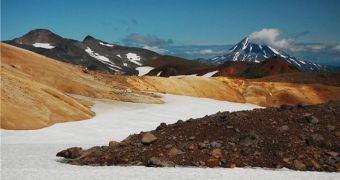A team of French investigators is currently traveling to Russia, in order to derive more knowledge of how past volcanic cycles in the Kamchatka Peninsula may have affected the early Earth.
The area is one of the most volcanically active in the entire world. Located in eastern Russia, the Peninsula is part of the Pacific Ring of Fire – the generic name given to all the volcanoes surrounding the Pacific Ocean.
Also in the Ring of Fire are the volcanoes of Japan and those in the Pacific Northwest region of the United States. The Andes mountains in South America are a result of the tectonic activity going on in the Ring.
Now, researchers Dr Agnes Samper, from the University of Quebec in Montreal, Canada, and Dr Pierre Lahitte, who is based at the University of Paris-Sud, in Orsay, France, are taking it upon themselves to conduct extensive analysis of the volcanoes in the area.
The main goal of their investigation is collecting more data on two renowned volcanoes, known as Mutnovsky and Gorely. The mountains are only separated by 15 kilometers, AlphaGalileo reports.
Studying these objectives is very important, the researchers say, considering the fact that the Kamchatka Peninsula has been the most volcanically active place in the world for the past 6 million years.
The new work will be conducted as part of the Europlanet Research Infrastructure’s Transnational Access Program, and will run from August 24 to September 7.
Other members of the research team include Kamchatka Volcanic Eruption Response Team expert Dmitry Melnikov and coordinator Nadia Evdokimova, from the Space Research Institute in Moscow.
“We will need to sample 2 to 3 [kilograms] of rock for each site that we wish to date, which promises heavy backpacks to bring back to the camp every night!” says Samper.
“But we are confident that the long and strenuous hikes will not curb our enthusiasm to understand the complexity of the fascinating stories of Gorely and Mutnovsky volcanoes,” she adds.
The two mountains turned into volcanoes some 700,000 to 800,000 years ago, and they have remained active ever since.
The research team now plans to gain new knowledge into how o if these activities influenced the development of the early Earth.

 14 DAY TRIAL //
14 DAY TRIAL //